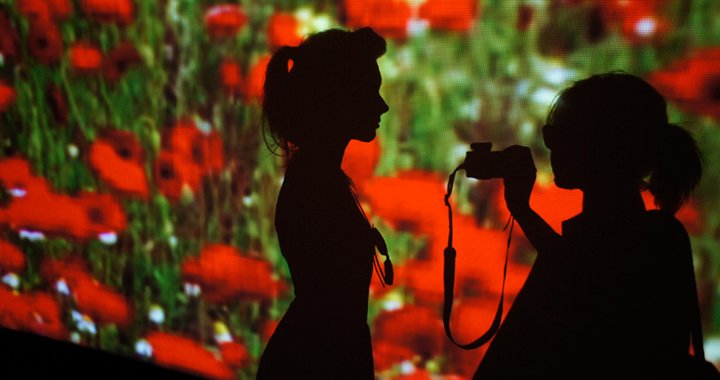
Experiencing ArtVilnius 2015. Cross Section
Rita K. Zumberga,
03/07/2015
Photo: Rita K. Zumberga
With its 6th edition, the only art fair in the Baltic region – ArtVilnius – seems to have raised its profile significantly among art aficionados: neither gallerists, nor ordinary visitors and potential buyers (allegedly including a few collectors) have been holding back praise. Recognising the significance of the event in the local context, Arterritory.com headed for Vilnius, keen to find out how substantial the content offered by our neighbours’ art fair really is, what the involved representatives of the art circles are talking about behind the scenes and which reference points have been singled out as the main ones by the organisers of the art fair.
Clever architecture. Pauses in business
Three years ago, well aware of the fact that a huge portion of the ArtVilnius visitors is comprised of ordinary residents of the Lithuanian capital and guests who go there to feed their interest in the latest developments in the contemporary art scene, the team of the art fair organisers set themselves the goal of creating more of a feel of an art exhibition, getting rid of the atmosphere of a trading platform. Bidding good-bye to the traditional ‘crates’ of gallery stands, architect Rokas Kilčiauskas chose a layout reminiscent of an art show, treating with respect both the art and the viewers and gallerists. Kilčiauskas stuck to the same principle when planning this year’s art fair, albeit introducing some small yet significant changes. ‘At last year’s art fair, sculptures and installations were displayed in a separate area; this year, we integrated them into the general exhibition, creating something like “pauses in business”’, says Kilčiauskas, who admits that he is, on the whole, happy with the new image of the art fair but still sees some tiny faults. ‘You have to make allowance for that if you are working with several artists at once. I cannot tell them that the general look is more important than their individual presentation.’
ARCHIVE: Photo Reportage from ArtVilnius 2015
Kilčiauskas has found a successful solution to the triangular Hall No. 3 of the exhibition centre: if you are looking down at the art fair from the balcony, it becomes obvious that the traditional straight aisles have been replaced by zigzag passages, guiding the stream of visitors past every gallery stand: not a single corner, not a single gallery remains unnoticed.
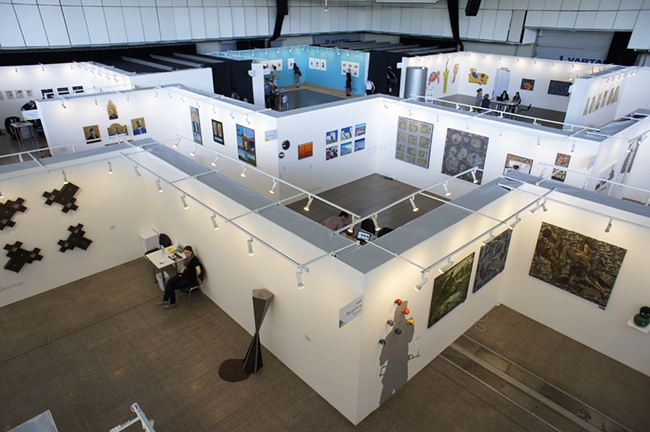
‘Last year a critic said that the structure of the art fair exhibition was similar to the layout of the Old Town of Vilnius: it is as if you were walking down some narrow streets, and the various façades of the Old Town revealed themselves to you one by one. While the model is, by and large, quite successful, it has to be said that the galleries were not always happy with everything; there were some objections to the effect that gallerists now had to co-exist and constantly look at the – according to them – not-so-great presentations of their neighbours. But there was much more squabbling about the whole thing last year; this year, ArtVilnius has already consolidated its position and won the status of a respectable institution among gallerists. More importantly, galleries have finally started to compete with each other in terms of a better presentation.’
Galleries and artists did not fail the viewer
This view was shared by viewers whose shoe toes, losing touch with the accustomed flooring, ended up in the sea sand brought to the exhibition by the Kaunas Photography Gallery; the splendid blue walls of the stand and Algimantas Kunčius’ photographs of opulent beach event scenarios from the last century spoke in favour of the unusual combination.
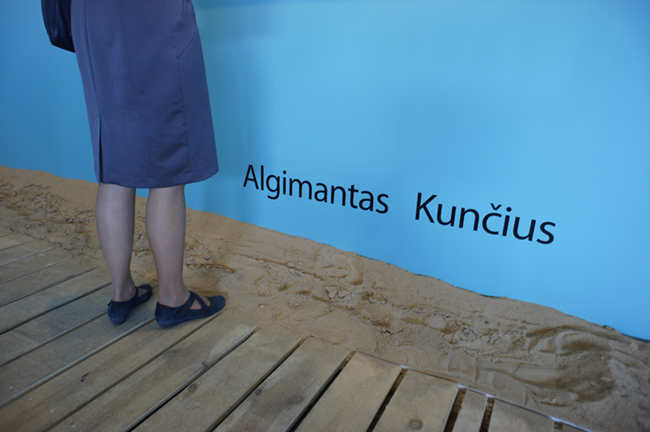
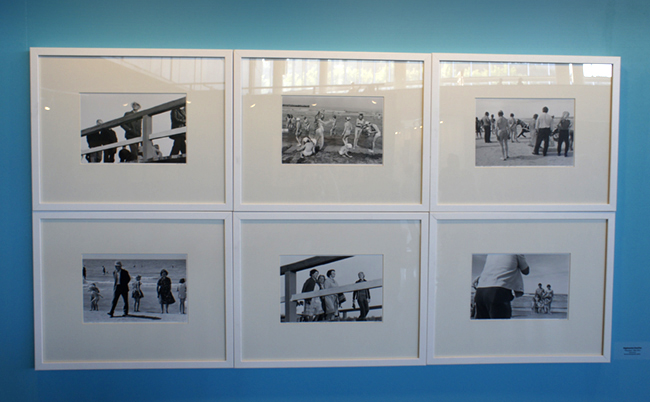
Director of ArtVilnius’15 Diana Stomienė let it be known that the Kaunas Photography Gallery was on of the favourite of the jury. In the end, however, it was the Prospekto Photography Gallery from Vilnius that was named as the best Lithuanian gallery at ArtVilnius’15. The experts agree: countless international awards speak of the potential of Lithuanian photography.
Elsewhere, representatives of Minsk were working hard, changing the display every hour and announcing to passers-by in huge letters in Belorussian that ‘Art Is Guilty’. Some remote black-curtained corners brought sudden revelations, for example, drawing you into some sort of hypnotic games: the red-haired Jurga Barilaitė (1979) in her witch-like take on the atmosphere of the primal act of creation was casting spells with such an inspiration, her rings flashing, that you had to look for exit in a state of slight dizziness.
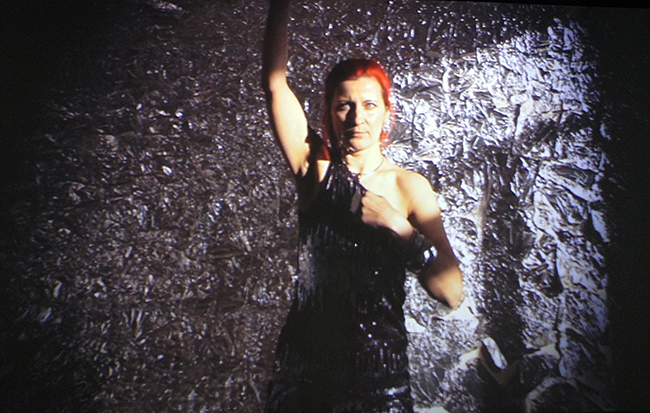
Jurga Barilaitė. Abracadabra Counting Rhyme
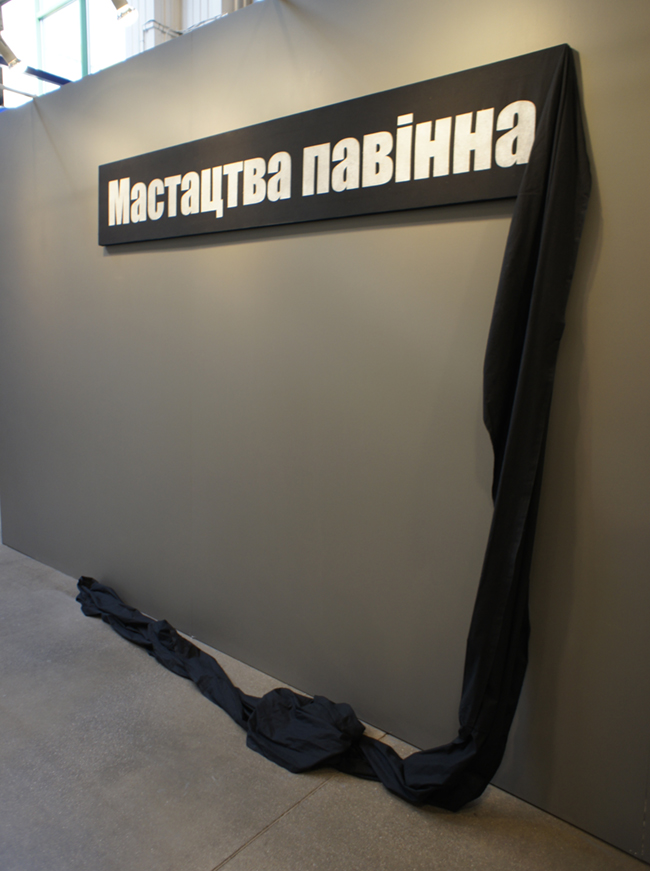
Ў Gallery claims that Art is Guilty. New works were unveiled at the gallery’s stand every hour
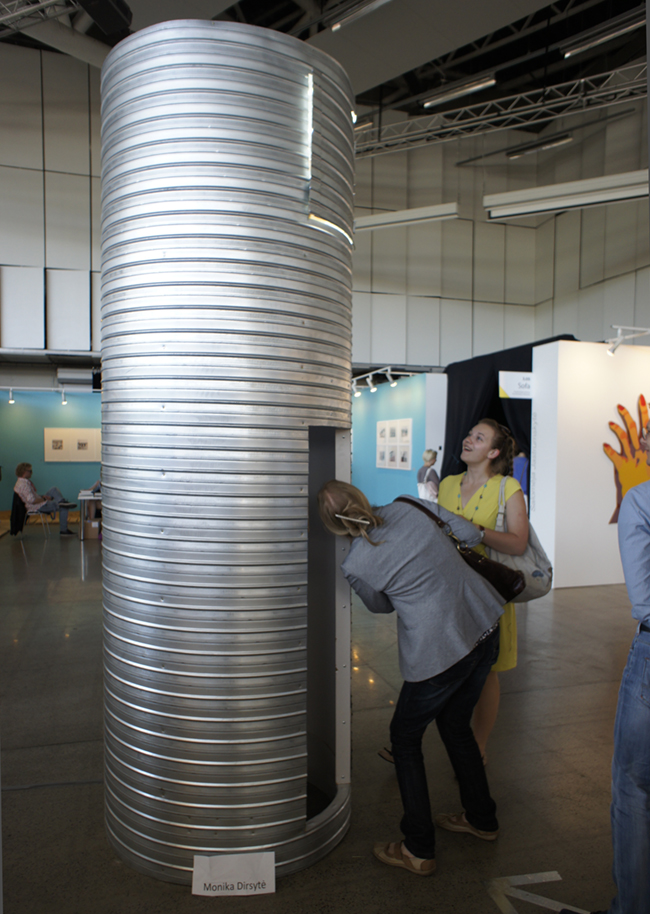
Monika Dirsytė. I'm Your Sun
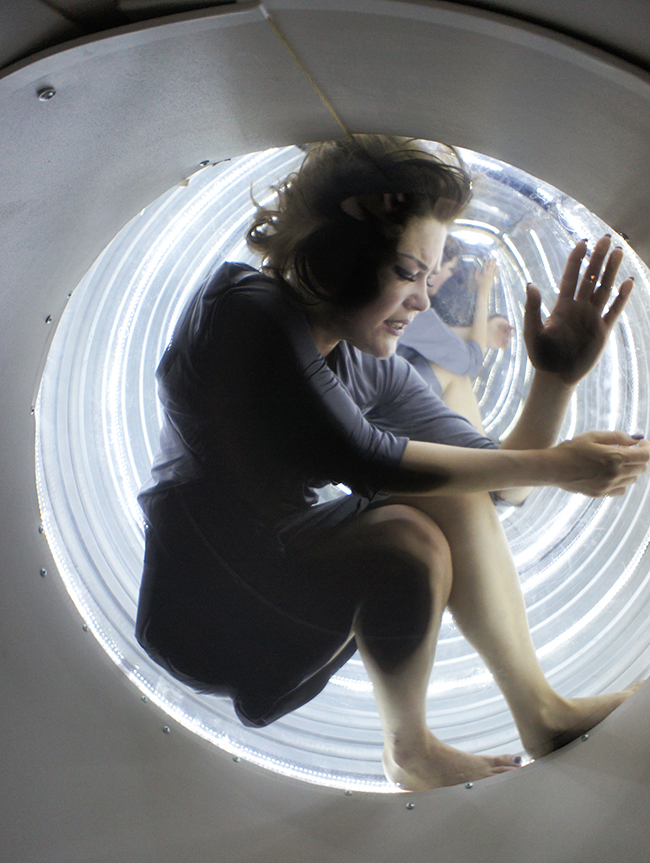
Monika Dirsytė. I'm Your Sun
Meanwhile a not-so-fine-looking aluminium barrel gave goose-bumps to everyone who, intentionally or no, found themselves in proximity to Monika Dirsytė’s ‘I’m Your Sun’ performance. Initially, hearing the desperate voice of a child, you were overcome by a sense of helplessness: it seemed that the silver-coloured cage had imprisoned a victim of a very tender age. However, after consulting a group of young Lithuanian visitors who kindly provided a translation, it became obvious that no-one was calling for help here. On the contrary; the pleading voice was coming in waves: ‘Don’t pass me by! Please don’t leave! Stay here, stay with me! I am your sun – I love you. Where did you go? Please stay!’ Every now and then a passer-by, tormented by curiosity, crawled in to take a peek at whoever was calling him or her. The surprise was immense: if you looked up to the bright light behind a glass ceiling, there was a figure of a grown-up woman ; curled up almost in coils, it emanated helplessness and power simultaneously. It goes without saying that the piece won Monika the audience award, making her the The Best ArtVilnius’15 Artist.
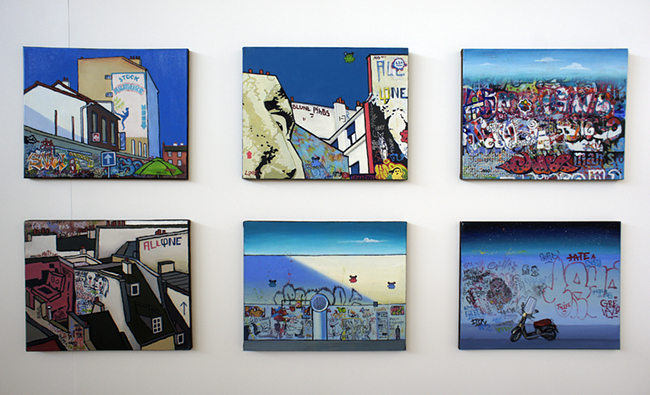
Julia Malinina. The Graffiti series. 2014. The Kovcheg Gallery
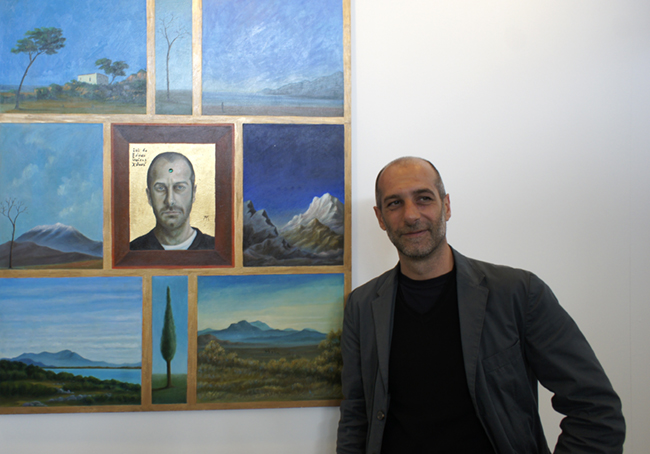
Tito Marci. Various works. 2005-2008. Oil, gold leaf. The Italian Institute of Culture in Vilnius
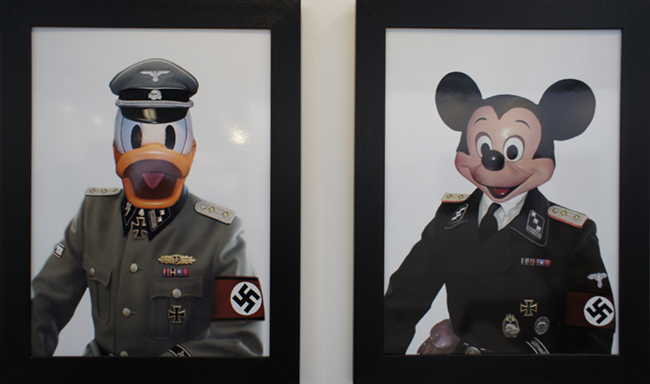
Max Papeschi. NaziFuckingMouse. NaziFuckingDuck. 2008. Digital print. UFOFABRIK
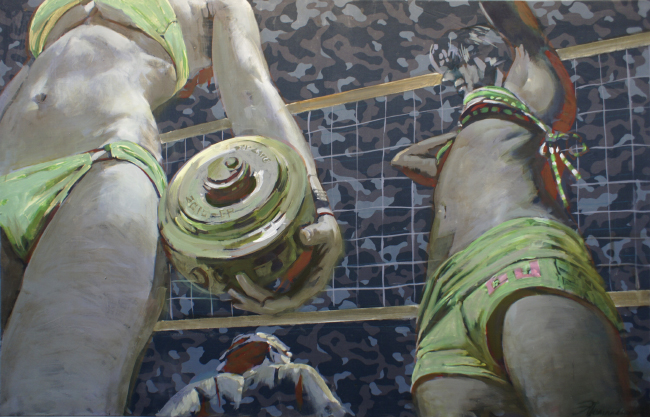
Eduard Potapenkov. In Game from the Hybrid Games series. 2015. Mixed technique
Some interesting exhibition material was also provided by representatives of visual arts: countless exciting story-lines tangled up in a multitude of techniques and genres. While Julia Malinina in her ‘Grafitti’ series featured details noticed in the street, the Italian artist Tito Marci had approached self-portrait as an icon, not skimping on gold details and complementing the images with quotations from ancient Greek books. Max Papeschi expressed his thoughts on the subject of war, using symbols of pop culture but Eduard Potapenkov explored the aesthetics of physical power in his ‘Hybrid Games’ series. Geometrical perfection, passionate female portraits, looking for a deeper meaning in mundane material banalities or even the journey of a mirror immortalised in photography: the gallery stands seemed to reveal a completely new world. And having already touched upon it – what is it with mirrors this year? Visitors of the art fair must have noticed the many mirrors – attracting attention, presented in unusual ways. One of them teased with its optic illusions: Christian associations provoked by a Virgin Mary-like face inspired reflections about a parallel world, while another, reminiscent of Snow White’s evil stepmother’s little helper, enveloped by a barbed wire shield and mystical mist, protected the viewer with the blindfold of anonymity.
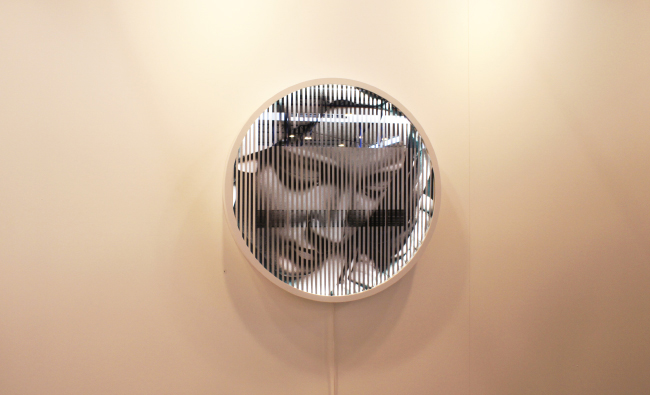
Julija Pociūtė. Trys atspindžio pusės. Meno Parkas
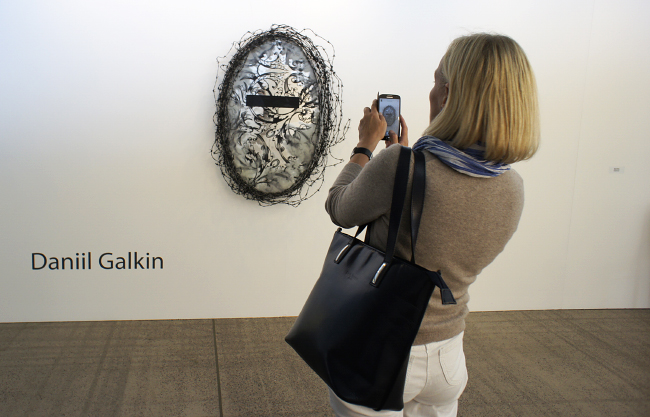
Daniil Galkin. Two Way Mirror. 2013. The Bottega Gallery
Among installations, the ones that became quite popular were casts of aged steel which, alternating with other crude materials, provoked reflections of a heavier nature. At the stand of the Kiev ART 14 Gallery, Glib Vishe-Slavskiy’s massive work entitled ‘Titanic’ pointed its spotlights at the eventual demise of the human race. Meanwhile the Lithuanian sculptor Rimantas Milkintas, who won the ArtVilnius award for the best installation back in 2011, was presenting a piece featuring rust-eaten beams, a play on the subject of semiotics.
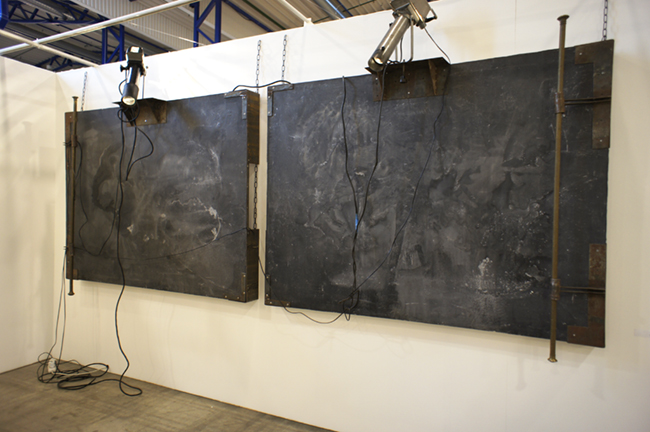
Glib Vishe-Slaviskiy. ‘Titanic’
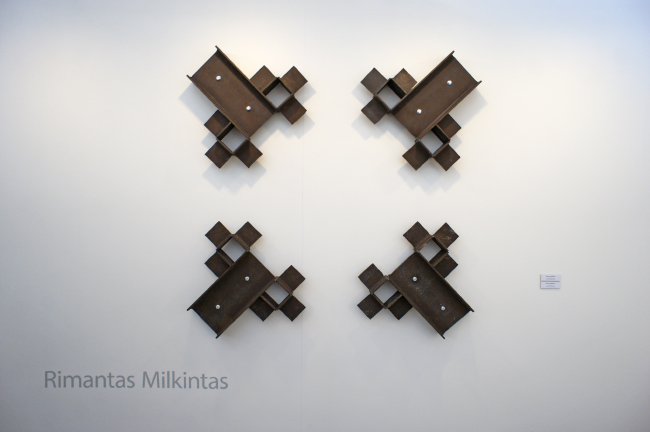
Rimantas Milkintas. ‘X’. 2014. LDS Šv. Jono Galtvės Gallery
Features of Lithuanian contemporary art
Undoubtedly, the organisers of ArtVilnius’15 have managed to bring the art fair closer to a high-quality exhibition format; with last year’s addition of the PROJECTS section, a separate room for simple enjoyment of art has been created, free of any business objectives. Since the majority of participants are still Lithuanian galleries, you could say that it does reveal the face of Lithuanian contemporary art of the moment. To present the most current of its features, the PROJECTS section also features Dainius Liškevičius, who, representing Lithuania at the 56th Venice Biennale, has made the most recent entry in the history of Lithuanian contemporary art. Likewise, a big event in the context of Lithuanian contemporary art is the creation of the Lewben Art Foundation collection of internationally acclaimed artists, part of which (works by Tony Cragg, Thomas Houseago, Charles Avery) was presented at the art fair.
Speaking of the phenomenon of Lithuanian contemporary art, we must not forget two of its flagships on the international art scene: the specially designed PROJECTS section that had taken over the whole of Hall No. 4 of the LITEXPO exhibition centre paid homage to the Lithuanian-born pioneer of avant-garde cinema Jonas Mekas and the legendary Russian jazz musician and artist Vladimir Tarasov, whose name is closely linked to Vilnius since the 1960s when the city became his home as he launched his musical career. It coincided with the time when the greats of jazz were at the centre of the avant-garde art scene and they were listened to by the most prominent figures of art and culture. At ArtVilnius’15, Tarasov showed part of his multi-media installation ‘The Sixties’ (2009), a vivid metaphor of the 1960s when many musicians used a certain substance to get their creative juices flowing.
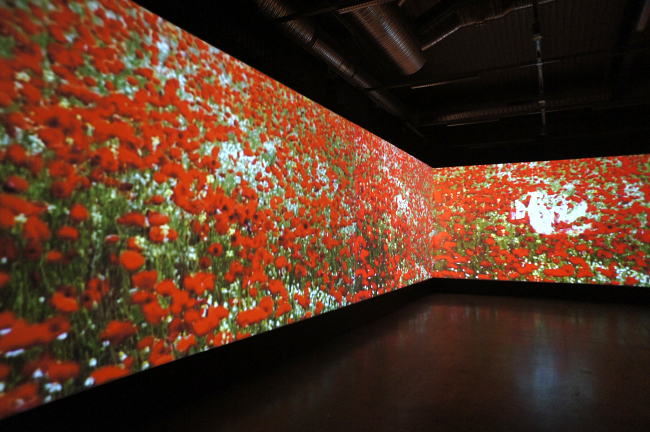
In the semi-darkness of Hall No. 4 visitors lounge on bales of pressed hay. The air is fragrant. An endless poppy field slowly ripples in the wind in large-scale video projections on two walls. Every now and then a cult musician from the 1960s appears in a video montage among the red flower heads: Miles Davis, Glenn Gould, John Coltrane, Ravi Shankar and Jimi Hendrix... We hear the sounds of the legendary San Francisco (Be Sure to Wear Some Flowers in Your Hair)...
The architect of the art fair Roks Kilčiauskas admits that, sadly, it had been impossible to provide the original version of the work where projections of a poppy field should mark all four walls of the room and the viewer would be swallowed by a sea of poppies, creating a more full-bloodied format of a multisensory space. He says that working with a great like Tarasov means understanding each other practically without words. He cannot praise enough a recent appearance by the musician: ‘He is a genius, he is a master. He performed a 20-minute percussion solo at the opening. You had to see it, you had to hear it to believe it! It was as if he were tearing your flesh apart and playing on a knot of naked nerves! And that was going on for twenty minutes non-stop. I have no idea how Tarasov does that. And it is the same with this video installation.’
Springboard for business or platform for new communication?
The title of this year’s special guests of the art fair go to the seven galleries from Ukraine; they have been granted the privilege of taking part in the art fair free of charge – confides Director of ArtVilnius’15 Diana Stomienė during one of our conversations. She admits that this has been a deliberate attempt to support Ukrainian gallerists and artists in light of the current difficult political situation. It may be a coincidence but Ukraine also won two of the main awards: ‘Siberia’, Nikita Shalennyi’s piece with the green made-in-China towels (2015) was named the best installation while the TSEKH Gallery took home the prize awarded to the best foreign gallery.
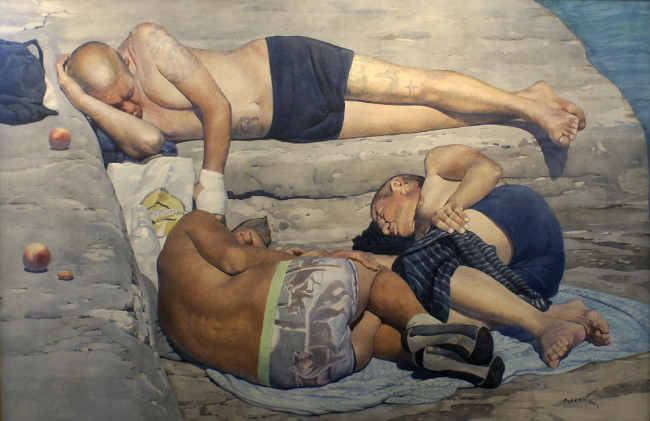
Watercolour Wolves (2014) by Ievgen Petrov, featured at the stand of the TSEKH Gallery, was chosen for the cover illustration of the latest issue of the legendary Literatūra ir Menas Magazine.
The TSEKH Gallery has been present at every edition of ArtVilnius, and its owner Oleksandr Shchelushchenko did not hesitate to reveal to Arterritory.com that it was Latvian collectors for whom he had been coming back again and again: ‘I am a fan of this art fair! I have an interesting story for you, my golden ladies from Riga... The first collectors whom I met on the very first day of the very first ArtVilnius were from Riga – Māris and Irina Vītols. On that occasion, they chose a work from the catalogue without even seeing it in real life; it was ‘Milk’ (2009) by my artist Ievgen Petrov. At next year’s art fair I made the acquaintance of another Latvian collector, Jānis Zuzāns, who bought five works from the stand. A purchase by a Lithuanian collector followed; then a number of works were bought by Ukrainian collectors. In 2014, Māris Vītols invited my man Petrov to mount a solo exhibition, ‘Petrov’s Dogs’, at the Riga Art Space.
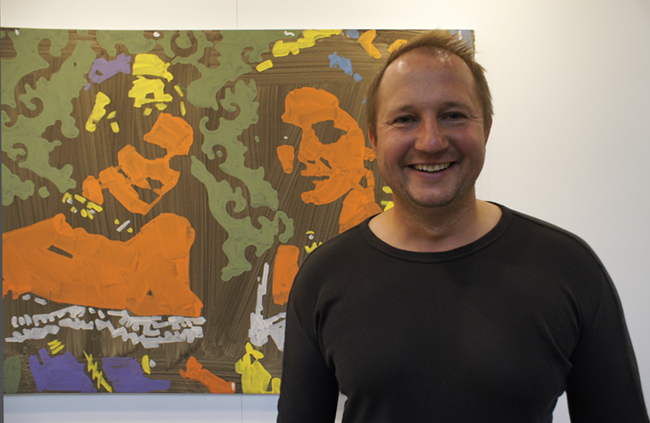
Oleksandr Shchelushchenko (in front of Mykola Bilous work At home) makes no secret of the fact that he sells three or our works by Petrov every week; flicking through the sizeable gallery catalogue, he reveals that 90% of the featured works have already been sold.
Riga is close to me, and so is Vilnius: these two cities have done a lot to support Ukrainian artists. And I have to say this – had the art fair not brought me together with these collectors, I probably would not have kept coming back. Today I am a member of the ArtVilnius board, and I have personally invited several collectors from London, Kiev, Warsaw, Dnepropetrovsk and elsewhere. They are here today, and this art fair can become an excellent platform for meeting people.’
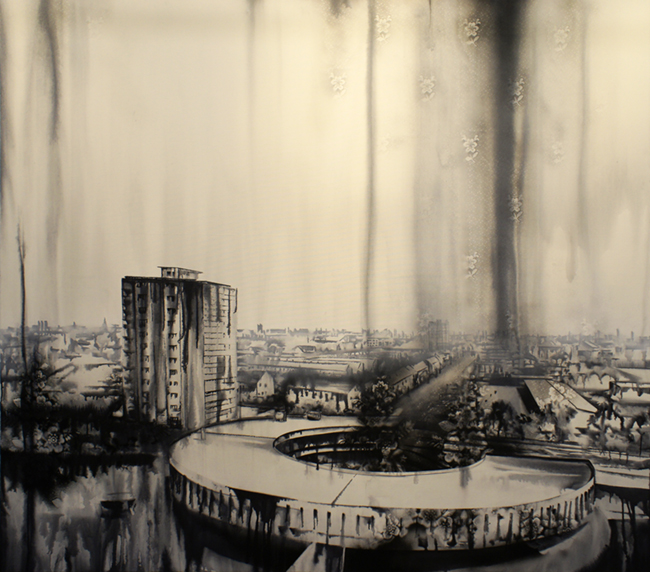
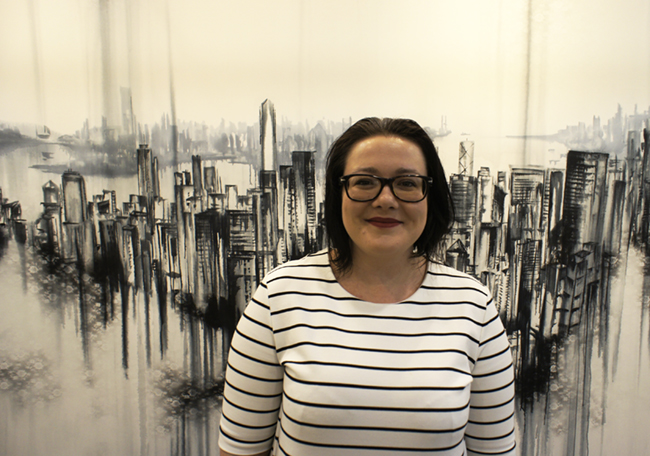
Lucia Tallova, represented by the SODA gallery, in front of her painting Hong Kong (2015), created two months ago during her travel to Hong Kong. The work shows the city’s skyline as viewed from Victoria Peak. In first painting by the artist features a depiction of typical Bratislava modernist architecture, creating a nostalgic and somewhat romanticised portrayal of urban landscape.
The presence of collectors is also noted by the Bratislava SODA Gallery; they admit that they would not be very likely to meet some of them at other European art fairs, for instance, the collector from Krakow who showed interest in Marek Kvetan’s sound and light installation ‘Carpet’(2009). Last year they managed to sell a sculpture by Viktor Frešo, another artist represented by the gallery.
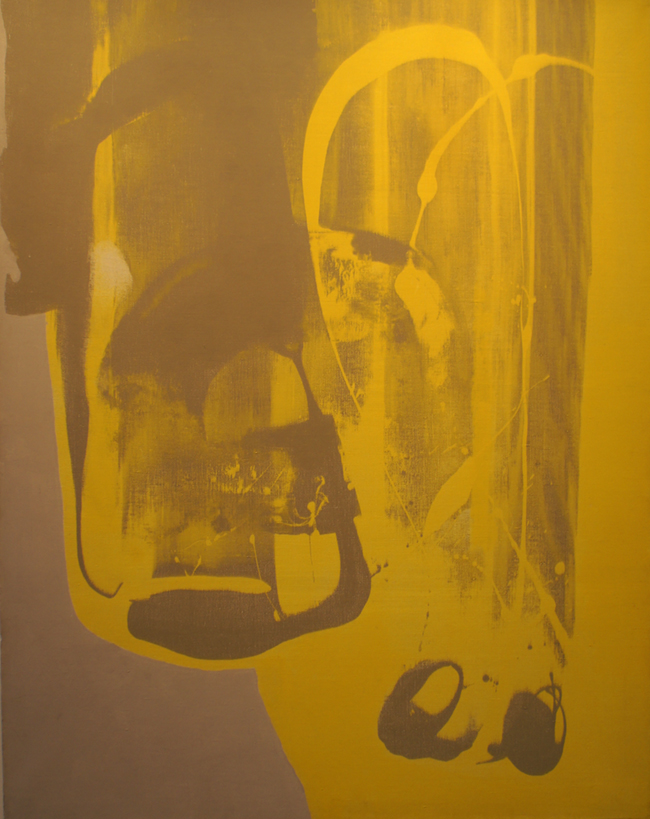
The Belorussian artist Alexander Zabavchik creates his painting with a single brush stroke, completely relying on the unpredictability of the result. The works can be hung both horizontally and vertically – in all four directions, which is why the artist usually gives each of his paintings four alternative names.
While it is the first time at ArtVilnius for DK Gallery from Minsk, Director Ekaterina Davydova views the art fair more in terms of a culture event; she is not afraid to admit that by the afternoon of the third day nothing has been sold yet; however, the viewers’ interest about Alexander Zabavchik, the artist represented by the gallery, is enormous. According to the organisers of ArtVilnius, statistics show that decent financial success is normally only achieved on the second time at the art fair; however, the benefits of art fair communication can also only be evaluated in the long run. Quite often the fanfare comes later, back at the gallery, where, following a negotiation, a deal is finally sealed.
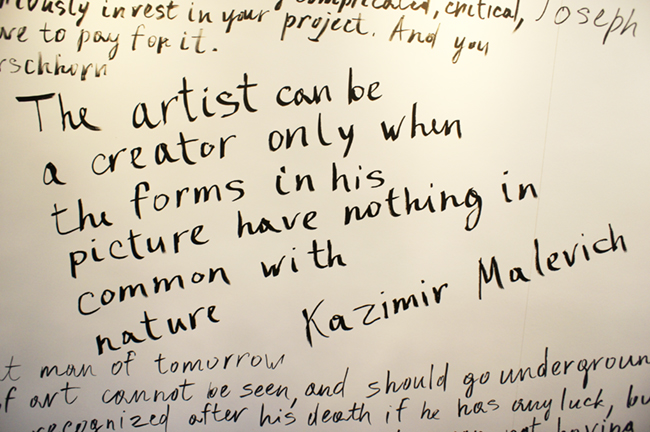
The exhibition of the Ў Gallery is centred on the question whether an artist has to be socially and politically active. The wall is covered with quotes from well-known artists on the subject.
For another Minsk gallery – Ў Gallery – this is the sixth time at ArtVilnius; the same as in 2011, last year it was named the best foreign gallery. The gallery representative Anna Chistoserdova admitted: ‘We are expecting a possible purchase by Lithuanian collectors this year. We’ll see if it works out.’ In any case, ArtVilnius is considered an excellent platform for making new contacts: so far, Ў Gallery has managed to agree on a number of great collaboration projects, for instance, last year the Lithuanian Meno Niša Gallery was invited to show in Minsk; this year, coinciding with the art fair, an exhibition of five Ў Gallery artists went on view at the Meno Niša Gallery.
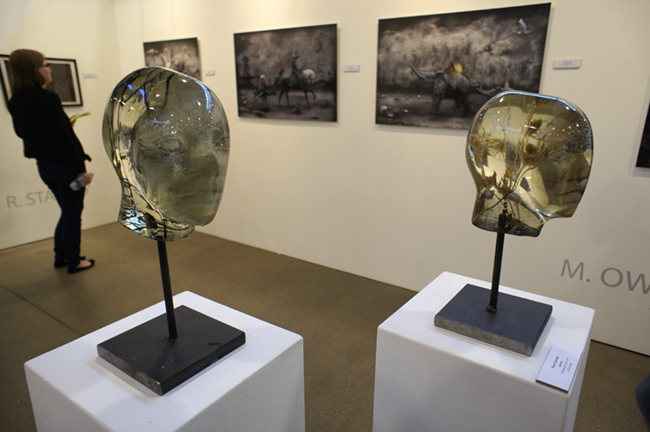
Oliver Czarnetta. Spectrum. 2015. The Best ArtVilnius’15 Gallery audience award - ArtCo Gallery (Germany)
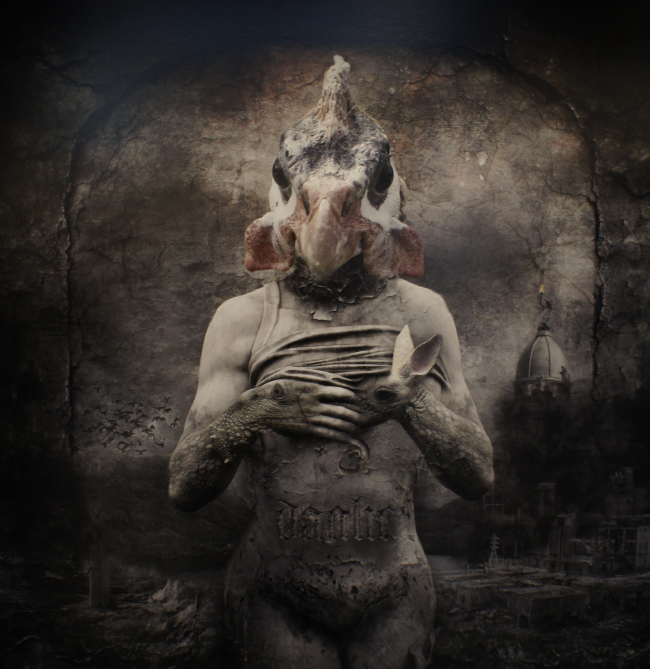
Marcin Owczarek. Cassandra. 2012. The Best ArtVilnius’15 Gallery audience award - ArtCo Gallery (Germany).
Latvia, ArtVilnius’18 promises marriage!
So how would we define the direction of ArtVilnius then? Could the Vilnius art fair become an important point of reference for local galleries and artists? Perhaps raising the recognisability and attracting new supporters are not such a bad thing after all – if the Kiev gallerist Shchelushchenko feels like interrupting a conversation about the most interesting works with an unexpected exclamation of ‘I met your sculptor Aigars Bikše! To me, he is like the Kurt Vonnegut of art.’
What gives special hope for further cooperation is the promise by Director of ArtVilnius Stomienė – in 2018, marking the centenary of statehood of Lithuania and Latvia, the emphasis of the art fair will be on Latvia. ‘We have already started negotiations with our Latvian colleagues, discussing the things to do and ways of doing them better,’ she laughs, also reiterating that there is no reason to fear that the art fair would become increasingly like an international art exhibition; the main objective still remains energizing the art market.